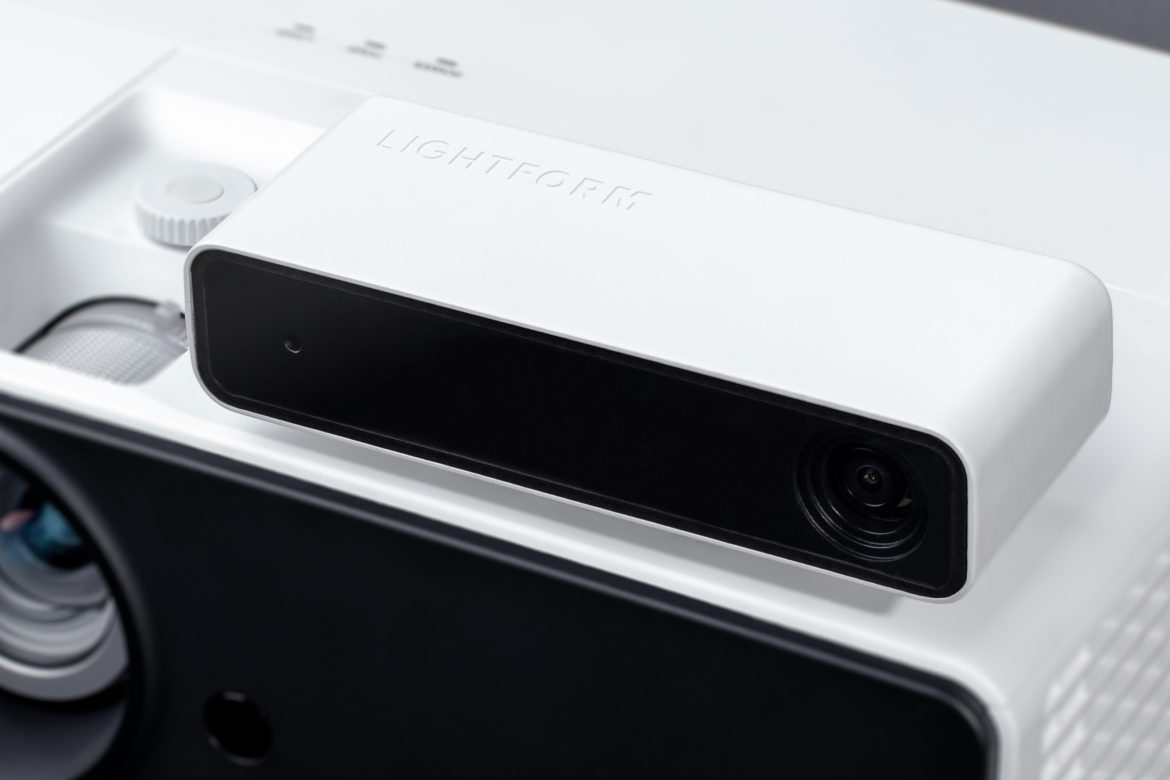We’ve been working on something for quite a while now, and we are excited to share a teaser of what we’ve been up to.
I’m happy to announce
- a $2.6M funding round from Lux, Seven Seas, NSF, and the former head scientist at Oculus.
- the launch of our company which has been in stealth for 3 years.
- a teaser of our product (which you can pre-order this summer)
Lightform is the first computer made for projected augmented reality, also known as projection mapping. By connecting Lightform to any video projector, you can quickly scan complex scenes and turn any object into a screen. It’s augmented reality without the headset.
The device uses computer vision to 3D scan its environment, then wirelessly transmits the data to our desktop app. The app uses this data to automatically generate effects and filters, so you can quickly create compelling projection mapped content. When things move, Lightform uses vision to keep content aligned. This makes it possible to permanently install projection installations quickly and easily.
The Future of Augmented Reality
We believe that virtual reality head-mounted displays (HMDs) are going to be huge, and that augmented reality HMDs aren’t far behind. Soon amazing immersive experiences will feel mundane from our the comfort of our swivel chairs. But what happens when we get up and go experience the world? HMDs have a lot of downsides: they only work for one person at a time, they take minutes to adjust per person, they run out of battery, they strain your neck, and worst of all they can even give you pink eye.
At Lightform, we are playing with a lesser known technology called projected augmented reality, or projection mapping. Projection mapping uses everyday projectors to turn complex objects into video screens. Today, projection mapping is usually limited to big budget productions like product launches, sporting events, and theater performances. It requires teams of experienced artists and technicians using expensive tools to make these events happen. Here’s what projection mapping looks like today, with content from various artists featured from our community blog on projection mapping.
Projection Mapping Made Easy
Lightform uses advanced computer vision to eliminate complexity in the projection mapping process. We want to democratize the medium so it can be used anywhere across film, art, education, cultural exhibits, events, signage, home entertainment, weddings, seasonal decor, theater, dance, and more.
We believe projected light can be inherently more interesting than a flat screen because it can be overlaid on the existing environment. This gives everyone the opportunity to seamlessly blend digital content with existing materials and structures. We frequently hear from architects, interior designers, and business owners who see projection mapping as an interesting alternative to TV screens, but don’t know where to start.
The Problem
Projectors used to be expensive, bulky, and required frequent bulb replacements. New LED and laser projectors are brighter, smaller, quieter, and can operate many years maintenance free. This makes projection an increasingly viable alternative to traditional screens for permanent digital art, signage, and ambient display applications. While advanced, these projectors are still “dumb” – they don’t know what they are projecting on.
Also, projection mapping involves a complicated workflow with multiple pieces of advanced software. Each step – from initial scanning, to 3D animation, to on-site calibration – requires a different artist or technician (usually teams of them).
With projection mapping things inevitably move in the real world, and even slight shifts in the set or projector alignment can noticeably ruin the effect. It currently requires tedious clicking around in clunky software to re-align the content. This is why you typically don’t see projection mapped installations outside of temporary events.
The Solution
Lightform offers the first end-to-end workflow for projection mapping, making it possible for a single user to scan, create content, and deploy an installation in one sitting. The workflow benefits experienced designers and novices alike. By leveraging computer vision, we automate tedious steps while assisting in the more fun process of content creation. We use 3D info to drive AI-generated effects and filters which users can quickly integrate into their projects. The experience is designed around one explicit goal: quickly turning scans of the real world into compelling motion content.
Also, Lightform is working on the latest computer vision techniques to automate the alignment process, letting the user focus on more on the installation and less on the technical execution. We believe that when paired with a long life, low maintenance LED or laser projector, Lightform will finally make permanent projection installations a reality.
Future Vision
We see projected AR becoming an integral part of architecture and interiors. As projectors are rapidly shrinking in size and increasing in brightness, projectors will eventually become as ubiquitous as light fixtures. Projectors will be small and bright enough to be installed like traditional lighting, simultaneously capable of standard illumination and high-resolution information display. This projection-as-lighting will enhance or create art, signage, decor, and interactive displays.
We are excited to share more about Lightform in the coming months. But for now, it’s back to work.
~Brett
p.s. press kit materials here.
